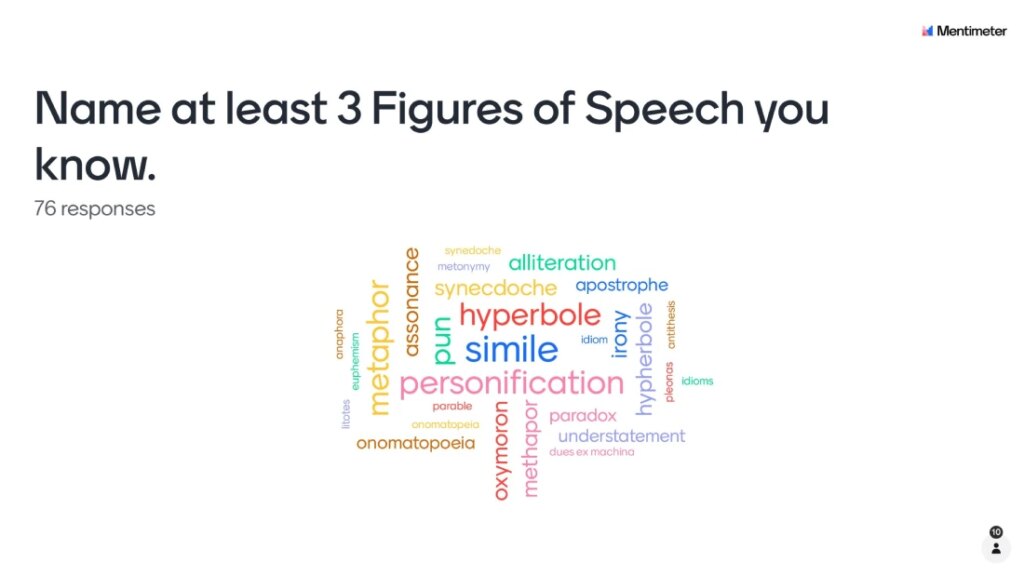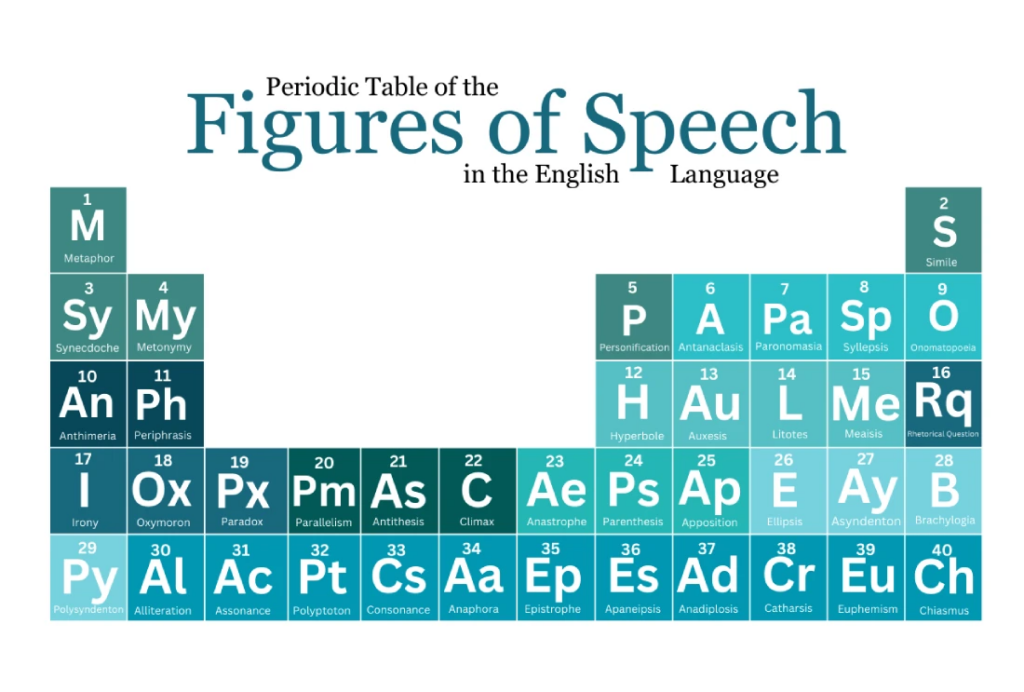總覽
如果科學有元素週期表,那麼英文也有修辭表格!有效的寫作始於了解如何在句子中使用單字,各種英文修辭都是為文章增添色彩的好幫手,尤其是在文學寫作中使用,可以幫助你更有創意地使用不同的修辭,例如創作詩歌、寫小說、編寫短篇故事及其他創意寫作。
通過英文中的各種修辭,能提高語言方面的創造力。在古時候以及現代文學,寫作各種類型的散文和詩歌是人們應具備的重要能力。
這種藝術形式可以根據讀者和主題選擇,用微妙地、諷刺地、浪漫地或幽默地方式表達情感,特別是使用的修辭技巧來表達訊息。
10種常見的英文修辭類型
使用Mentimeter應用程式作為調查工具來收集與英文修辭相關的數據,受訪者根據他們在過去所學到的知識,給出了以下這些詞。他們被要求列出至少三種他們知道的英文修辭,根據回應者的回答,這些是常見的答案。
在這份關於英文修辭的調查中,比喻(Simile)名列榜首,其次是誇飾法(hyperbole)、擬人法(personification)和隱喻(metaphor)。然而,許多英文修辭在上方圖片中並未呈現,這些修辭不常被使用,但在創意寫作中可能有用。

1. Simile (譬喻法)
這種英文修辭用來比較事物,使用“like”或“as”來進行比較。將實體與另一個相似的事物進行對比,將具有共同特點的事物聯繫起來。
例句:
- You look like an angel in disguise.
- Jane is like a lion when mad.
- Stella is as bright as a star in our classroom.
- Her physique is as lovely as aurora borealis.
- Agatha is as fragile as the dandelions in the garden.
“Worrying is like a paying debt you don’t owe.”
-Mark Twain
2. Metaphor (隱喻法)
用於直接比較不具體的兩個事物,也是一種透過比較想法或類比來顯示物體之間的關聯性來賦予物體意義,不使用“like”和“as”。
例句:
- She is a walking disaster.
- Anthony is a living dictionary in my school.
- Life is a journey, full of adventures and mysteries.
- Time is gold. Use it wisely!
- A pen is mightier than a sword.
“I watered it with fears,
night and morning with my tears.
I sunned it with smiles.”
-William Shakespeare
3. Hyperbole (誇飾法)
對某種想法的誇大的描述,英文中的這種修辭使用了許多情感,如憤怒、快樂、悲傷等,可以在某種程度上表達某些事物。
例句:
- What a tiring day! I could sleep for a year.
- His anger could boil a cup of water.
- Anna cried in the river when her Mom died.
- Tiffany dropped Troy’s golden glass heart.
- John’s smile reached through his ears when he saw his crush.
“Her voice was a rich, vibrant contralto of intrinsic beauty.”
-Alan Blythe
4. Personification(擬人法)
賦予無生命的事物、物體生命。作家和詩人用擬人法來將情感和人類特徵賦予植物、玩具、自然界中的事物。
例句:
- The sunflowers are dancing in the garden.
- The sun is angry towards the humans.
- Three birds are singing in a choir in the sanctuary.
- The fog is hugging sweetly to the mountain.
- She took a photo under a crying sky.
“The fog comes on little cat feet.
It sits over harbor and city on silent haunches and then moves on.”
-Carl Sanburg
5. Oxymoron (反義法)
英文中的這類修辭是由兩個相反或矛盾的單字排放在一個句子中以創造另一種含義。人們故意使用矛盾法來產生戲劇效果或解釋特定的事物。
例句:
- The town had a reality show last fiesta.
- I am clearly confused with his explanation.
- Josh ate the jumbo shrimp on the table.
- Due to globalization, we created a global village.
- Allan and Sam have similar differences together.
“Feather of lead, bright smoke, cold fire, sick health,
Still-waking sleep, that is not what it is!
This love feel I, that no feel love in this.”
-Romeo and Juliet; William Shakespeare.
6. Paradox (矛盾法)
在一個句子中使用兩個對比或相反的想法來傳達訊息。這聽起來很愚蠢,但背後卻有更深的意義,也能用更有趣的方法解決事情。
例句:
- I find strength in my weaknesses.
- I took the courage to get out of my fears.
- War is the only way to have peace.
- People helped him to go up just to look them down.
- Intelligent people talk less.
“Someday you will be old enough to start reading fairy tales again.”
-C.S. Lewis.
7. Irony (諷刺法)
一個人的表達與他想要傳達的意思相反。英文中的這一類修辭也用於諷刺、批評和對問題或所說內容的嘲諷。
例句:
- The mouse chases the cat.
- Teacher Dwight has a fear of public speaking.
- The police officer ran away when he saw the suspect.
- What a great day! I just lost my wallet.
- Oh! They are out of unlimited rice.
“A pair of star-crossed lovers take their life.”
-Romeo and Juliet; William Shakespeare
8. Onomatopoeia (擬聲詞)
英文中的另一種修辭,是用一個字來模仿動物、自然等的聲音。
例句:
- The splashes of the water create a relaxing sound.
- I can hear Jessica’s deep gulp after breaking the vase.
- Tick tock, Tick tock! What time is it?
- The duck quacks loudly in the river.
- Bamboo squeaking every night sounds creepy.
“Yet the ear, it fully knows,
By the twanging,
And the clanging,
How the danger ebbs and flows.”
-The Bells; Edgar Allan Poe
9. Alliteration (押韻)
這是一種在後續單字中重複第一個子音的雙關語。用於玩弄聲音以產生單字的押韻。
例句:
- Jack on Jumpers jumps with jars of jam.
- Willy whips a willow in the window.
- Railey reaches Rocky Road railway.
- The busy bumble bee buzzes on the bluebell bud.
- Gian guards the green garden.
“While I nodded, nearly napping, suddenly there came a tapping.”
-The Raven; Edgar Allan Poe
10. Pun (雙關語)
在句子中有趣地使用單字。發音相似但意思不同的單字,這種英語修辭。
例句:
- Why are Teddy Bears hungry? They are always stuffed! (Stuffed Toys)
- Let us taco about it. (talk)
- I am board I wish someone wood have fun. (bored; would)
- Are you a tower? ‘Coz Eiffel for you. (I fell)
- Do clay sheets get tired of being overused? (clichés)
“Now is the winter of discontent,
made glorious summer by this sun of York.”
-Richard III; William Shakespeare

10 種不常見的英文修辭
除了上述常見的英文修辭外,還有一些很少使用的修辭對寫作有幫助,但這些只是英文修辭長列表中的一小部分:
1. Litotes (反述法)
是使用否定來表達肯定的委婉說法。例如,”That wasn’t half bad”(那並不算差)使用了否定的表述,實際上是表示某件事非常好。
例句:
- You are not ugly. (You are beautiful.)
- It is not a bad day. (It is a peasant day.)
- The government officials are not fooling around this year. (The government officials are serious this year.)
- Shane doesn’t have a few mistakes. (Shane has many mistakes.)
- Their platform is not uncommon. (Their platform is common.)
“Beowulf raised the hard weapon by the hilt,
angry and resolute — the sword wasn’t useless to the warrior.”
-Beowulf; Oldest English Epic
2. Antonomasia (換喻法)
用來代替人的名字。這種英文修辭手法也用於隱藏某人的身份,稱為別名、筆名或頭銜。
例句:
- The King of Pop made the music industry boom. (Michael Jackson)
- In England, the Bard of Avon made many literary pieces. (William Shakespeare)
- I just found my Mr. Right! (Boyfriend)
- The Iron Lady of Asia passed away after the National Election. (Miriam Defensor Santiago)
- The Star of Miss Saigon is going to Japan. (Lea Salonga)
“The fatal Cleopatra for which he lost the world and was content to lose it.” (Antony)
-Antony and Cleopatra; William Shakespeare
3. Euphemism(委婉法)
是一種間接解決某些問題或用溫和的詞語代替嚴肅的詞語的文學手法。尤其是當言語過於尷尬或不愉快時,這種英文修辭用於避開禁忌話題。
例句:
- Gio’s grandmother passed away. (died)
- Anthony’s dad is a Sanitation Engineer. (garbage man)
- Anne had a pregnancy termination! (abortion)
- Mentally challenged people need guidance. (retarded)
- Sue had a big bone but look at her now. (fat)
“I am one, sir, that comes to tell you your daughter and the Moor are now making the beast with two backs.” (having intimate intercourse)
-Othello; William Shakespeare
4. Synecdoche(借代)
是一種比喻法,用一個字來代表整體。使用借代法能讓讀者想到大事物的某個部分,例如一群人、物體等等。
例句:
- Rey bought new wheels yesterday. (car)
- John asked Lucy’s hand in the middle of a concert. (asking to marry)
- I forgot to bring my Band-Aid with me. (bandages for wounds)
- Sean has 5 mouths to feed at home. (family members)
- I found a good head in our team. (intelligent person)
“I should have been a pair of ragged claws
Scuttling across the floors of silent seas.
-The Love Song of J. Alfred Prufrock; T.S. Eliot
5. Metonymy (轉喻)
一種文學手法,用於將某特徵做為代表,與整體聯繫起來。這種英文修辭可以引導讀者思考。
例句:
- I will adhere to the crown’s orders. (King)
- Pen is mightier than sword. (writing; war)
- The White House declared a global lockdown during the pandemic. (the President)
- I hear many tongues one at a time when I visit the city. (languages)
- Do you need any hand for that? (help)
“Half in appeal, but half as if to keep
The life from spilling”
-Out, Out; Robert Frost
6. Apostrophe(頓呼法)
英文修辭中用於稱呼已不在世、不在當下且無法回應的人。用來對死去的人、一件事、一個問題、對世界等說話。
例句:
- Oh! My beloved moon. Why are you so beautiful?
- I am sorry Mother Earth, I failed to protect you.
- My Persephone, I wish you were here.
- I will fight for you, My Philippines, until my last breath.
- How to make you calm, Sun? Your rage is burning.
“Thou wast not born for death, immortal Bird!
No hungry generations tread thee down;”
-Ode to a Nightingale, Jean Keats
7. Chiasmus (交叉句)
英文修辭中的另一種雙關語,使用概念和單字的順序相反,傳達另一種意義,能在寫作中創建節奏。
例句:
- A man for a woman and a woman for a man.
- One for all, all for one.
- He knows us and we know him, too.
- John gave knowledge to us and our ignorance has been taken.
- It takes love to sacrifice and it takes sacrifice to love.
“Let us never negotiate out of fear, but let us never fear to negotiate.”
-John F. Kennedy
8. Anadiplosis (頂真法)
一種文學手法,使用句子的最後一個單字作為下一個句子的開頭。這種修辭是目的是為所使用的單字添加節奏。
例句:
- The boat sinks; sinks slowly into the ocean; the ocean of nothingness.
- The government had corruption. Corruption that would lead to problems. Problems that would lead to poverty.
- The seen turned to bud. The bud turned into a flower. The flower wilted in despair.
- I file an application letter. An application letter for a job. A job that will make me a billionaire.
- The boy is writing a congratulatory letter; a congratulatory letter for his best friend.
“The general who became a slave. The slave who became a gladiator. The gladiator who defied an emperor.”
-Gladiator Movie
9. Anaphora (首語重複法)
在下一句中重複第一句的第一個單字或短語,強調所指的想法、概念、人、事物等。
例句:
- You are kind. You are talented. You are intelligent.
- Jane sings sweetly. She is a diva. Her voice deserves an award.
- I will fight for you. I will make you happy. I will be a better man.
- Joe sees nothing. Joe hears nothing, too. Joe is blind and deaf.
- The government is bad. It steals money. It kills innocent. It is such a shame!
“You may shoot me with your words,
You may cut me with your eyes,
You may kill me with your hatefulness,
But still, like air, I’ll rise”
-Still I Rise; Maya Angelou
10. Anthimeria (轉品)
是一種將名詞轉換為動詞的文學手段;單字規則的功能性變化。
例句:
- I will phone you later.
- I can keyboard this letter in just one minute.
- Will you please google this page?
- Chris turtled John’s assigned paperwork.
- The facts are not facting.
“The thunder would not peace at my bidding.”
-King Lear; William Shakespeare

為什麼要用修辭?
有很多方法可以使簡單的文字變得更加生動美麗。尤其是當我們想明確地向某人表達某件事時;又不想太過直接,就可用較微妙的和有創意的方式表達。藝術不僅限於視覺,還包括語言學。以下是在我們的生活中使用英語修辭的好處和重要性:
- 創意最大化
透過英文修辭可以增強和發展更多的創意思考能力。可以將單字的上下文與許多事物聯繫起來,例如環境、政治、自然、愛情、社會等。
- 展示療法
透過寫作表達情緒是藝術治療的一種方式,我們稱之為宣洩。不直接用口頭表達,而是透過創造性的言語來隱藏意圖。透過使用英文修辭,可以釋放情緒。當你感到悲傷時;當你感到憤怒時;當你感到壓抑時,等等。
- 靈巧運用
在寫作中應用英文修辭格時,可以釋放您的思維靈活性,這是一種快速創造性思考、寫作和表達的方式,尤其是即興寫作。可以將思想與文字聯繫起來,透過使用修辭,能反映出英文程度。
請點擊此 PDF 文件,查看如何改進簡單句子的比較。
小撇步
使用英文修辭可以提高英文流利程度,還可以提高創造力、促進治療並提高靈活性。但英文修辭並不總是適用於所有情況。
請保持敏銳並注意訊息的情況、環境和性質。例如,在辦公室、報告、研究和其他正式場合就不適合用太多修辭。





